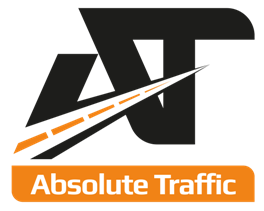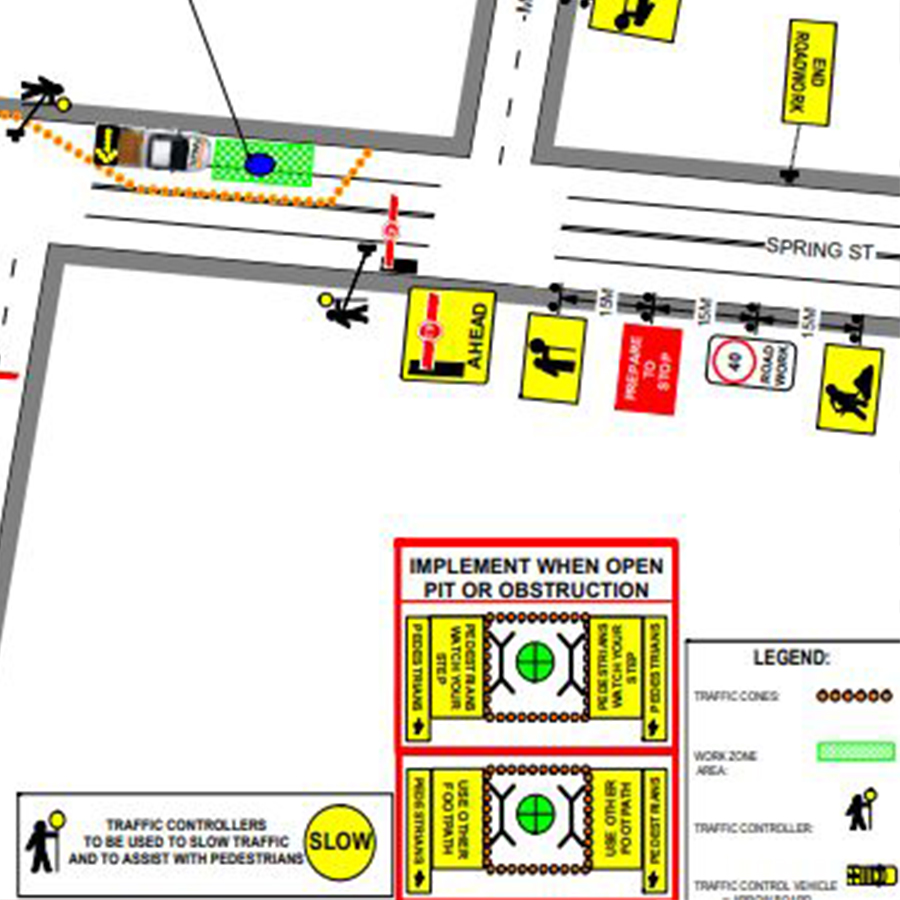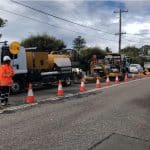TGS and TMP are tools to help you manage traffic safely on your worksite. When your undertaking requires a road closure, you need to provide a traffic management plan to council. In fact, you must prove that you make sure to eliminate or reduce any health and safety risk that may exist, through TGS and TMP.
To do so, you need a Traffic Management (TMP) or Construction Traffic Management Plan (CTMP). And, this plan may include a number of Traffic Guidance Schemes – formerly called Traffic Control Plans (TCP). So, what are exactly TGS and TMP in construction? And, how to develop TGS and TMP?
What are TGS and TMP
Traffic Guidance Schemes
Traffic guidance scheme selection and implementation in New South Wales must take into account several factors to guarantee the safety of workers and drivers, and to allow an efficient movement of traffic.
For example, the type of work, the number of lanes in the road or carriageway, the shoulder grading, or the bitumen surfacing. And, it must give information about vehicle speed, the manner of traffic diversion, length of time the road will remain under construction.
At Absolute Traffic Management, our strong and experienced team guarantees every project runs as smoothly as possible. We provide 24/7 support. Get in touch to learn more.
Manage Risks With Traffic Management Plans
First, some developments have to submit construction traffic management plans to councils for approval. In short, a traffic management plan explains how the construction workplace manages risks. So, creating a traffic management plan helps outline the way the construction business implements activities on the road.
And, this implementation needs to ensure that both workers and road takers are safe from potential risks and danger. In line with this, a local transport officer should approve a TMP prior to any road works and activities.
In addition, a traffic management plan also supports workers. It determines what safety equipment the construction site needs to protect people. For example, safety cones, fences, barricades, traffic lights, and closed road signs to properly establish work zones. Absolute Traffic Management can supply a comprehensive range of Sign and Device Hire.
Moreover, with such a plan, traffic management teams can create a protective zone to organize traffic alongside the worksite. Lastly, a traffic management plan is essential to safely do road construction plans and projects without disrupting the normal traffic flow.
Absolute Traffic Management is the specialist of construction traffic management plans. So, get in touch now to get a permit and approval for a works zone. We will complete the form and other documentation to submit your application to council.
Develop a Traffic Management Plan (TMP)
Basically, ‘traffic’ refers to the interaction of vehicles, mobile plants (machinery) and pedestrians. So, you need to think about when and where in your workplace this type of interaction may occur. And, determine what risk controls the place needs.
Identify the areas with a risk of a collision
First, you need to identify areas where pedestrians may face the risk of a collision between mobile plants or vehicles. For example, in a warehouse where forklifts and workers both operate. In this case, you can create exclusion zones.
Then, consider the current traffic flow on your worksite by mapping out all possible movements of mobile plants and vehicles.
Also, identify collision points by mapping out pedestrians’ regular routes and seeing where they overlap with mobile plants and vehicles. Consider entry, exit, pick-up and drop-off points.
Identify the safest routes
And, identify the safest routes – identify the safest routes to be taken by mobile plant, vehicles and pedestrians and clearly mark them on the site plan.
On the one hand, a traffic management plan covers how workers can be safe during a road project. On the other hand, it specifies the workaround to prepare for cyclists, pedestrians, and other road users.

What to include in a Traffic Management Plan (TMP)
In short, it must contain the specifics of the project. Such as the location, time shifts, workers, the work processes, contact details, as well as traffic management design plans. In detail, it should cover:
Traffic Management Design Plan
Firstly, the design plan illustrates the traffic during the operation. Therefore, it helps ensure safe movements of the vehicles alongside the road work equipment. In addition, the plan should underline potential hazards in the area and suggest suitable traffic flow.
Also, it is important to determine the types of vehicles that usually pass through. Because it allows proper measurement and distance, it considers the width and turning radius between the work zone and the main road.
Lastly, the design plan should also include parking, nearby establishments, and other significant places where people stay or pass-through.
Traffic Management Plan Implementation
Secondly, the plan should include the following information:
Plan Maintenance
Then, 3 design phases can compose the maintenance of the traffic management plans. And, each phase gives opportunities for traffic planning designers to coordinate with key people.
Alteration or Removal of temporary traffic management (TTM)
1) Travel Paths
Next, this includes how the team will remove the signs and equipment like barriers, and other devices. In particular, it describes the travel paths for vehicles, routes for debris or plant and materials, or traffic crossing other streams of traffic. And, it includes the pedestrian and traffic routes, delivery and loading and unloading areas.
In addition, this part describes the travel paths on routes remote from the workplace including places to turn around, dump material, access ramps and side roads. And, how often and where vehicles and pedestrians interact.
2) Traffic Control Measures
Then, the traffic control measures for each expected interaction. So, this includes drawings of the layout of barriers, walkways, signs and general arrangements to warn and guide traffic. A risk controls implementation means for instance using exclusion zones, signage, speed limiting devices, one-way traffic, etc.
Also, this plan includes the requirements for special vehicles like large vehicles and mobile cranes. And, the requirements for loading from the side of the road onto the site. Moreover, it describes the responsibilities of people managing traffic at the workplace.
At Absolute Traffic Management, we have experience working on construction sites, mobile works, and emergency works. But, also road closures, traffic management & pedestrian management. So, enquire today about our Traffic Control Labour Hire Services and leave it to the experts.
Furthermore, it includes the instructions or procedures for controlling traffic including in an emergency. Finally, it describes how to implement and monitor the effectiveness of a traffic management plan.
3) Plan Monitoring
Especially, managers should monitor and review the traffic management plan regularly including after an incident. In particular, to ensure it is effective and takes into account changes at the workplace.
Last but not least, workers should understand the traffic management plan and receive information, instruction, training and supervision. And, site induction should include the traffic management plan. Display the new site plan prominently, and require all workers to comply with it.
Prepare a Construction Traffic Management Plan (CTMP) report
A CTMP report assesses traffic impacts on the local road network. First, it provides a description of the construction works. Second, the traffic impacts on the local area. And third, how the company will manage these impacts.
Specifically, the CTMP should include the following elements:
1. An Introduction:
2. The Management of Construction Vehicles:
3. The Project’s Impact:
Here, the report provides details of the impact of the works. In detail, it includes the impact on residents, businesses, pedestrians, cyclists, local traffic. And, on emergency services and management of staff parking.
TGS and TMP in construction
So, do you need a traffic plan solution: TGS and TMP? Then, enquire now! Based in Sydney, we provide thorough TGS and TMP solutions in all NSW. And, no matter big or small, we provide plans for all types of projects.









